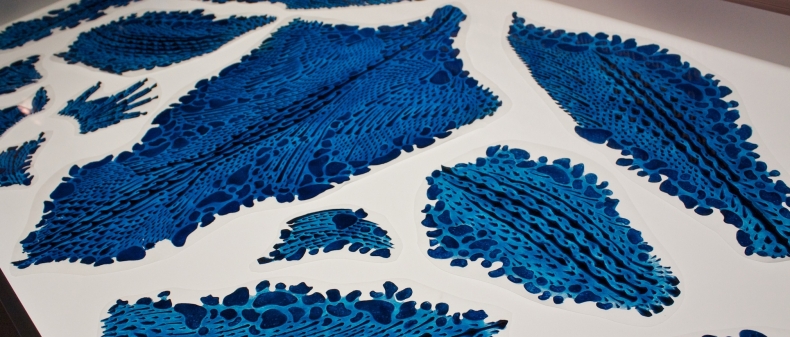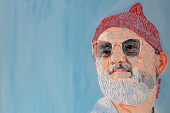
All photographs by Lucy Doan
By: Mai Nguyen
A good illusion is the sum of two things. One, a viewer’s flawed perception. And two, a brilliant deceiver. Gordon Smith is, for all intents and purposes, a master at deceiving. He’s a special effects makeup artist who’s created some of the most arresting illusions in film. During his 30-year career, the southern Ontario native beat out Hollywood FX powerhouses to work on over 80 motion pictures including Kathryn Bigelow’s Near Dark, David Cronenberg’s Dead Ringers, and five Oliver Stone films. Disfigured faces, bloody lesions, smashed limbs, the stuff your nightmares are made of, Smith can do it all. He once created a corpse of John F. Kennedy for Stone’s JFK that was so convincing a coroner thought it was real and freaked.
Smith was largely unknown until he worked on Bryan Singer’s blockbuster X-Men and its sequel X2. He produced special effects for the power-possessing mutants of the cult comic book adaptation. The results were captivating. Now, his revered creations will be showcased at the TIFF Bell Lightbox, an archive that includes Wolverine’s retractable blades, Nightcrawler’s mechanical tail, and above all, the silicone prosthetics that he single handedly revolutionized.
His unprecedented work on X-Men earned him some nominations as well as some monikers. Master. Pioneer. Legend. But if you ask him, he’ll say he prefers just “Gord.” Humbleness aside, it’s clear why folks in the FX industry are praising him. Take a look at Rebecca Romijn’s character, Mystique, a naked six-foot-tall scaly blue mutant. Was it paint? Was it CGI? No, it was “Gord.” Mystique was a product of silicone prosthetics that Smith spent 15 years developing. Never before had it been used in film. Out of his small two-storey studio in North York, Smith had been working with chemists, medical specialists, and artists to develop a revolutionary technology that made it possible for Mystique’s blue scales to look skin-like without any digital enhancement.
Since the beginning of prosthetics, artists have tried to create the ultimate illusion: translucent human skin. The materials that were available had been imperfect. Foam was too opaque. Gelatin yellowed over time. Latex had its health risks. But when silicone hit the market, it stood out as the Rolls-Royce of them all. It was designed to act, move and respond like living tissue. Smith saw the potential of this crystal clear material and became the first person in the entertainment industry to make prosthetics out of it. His first project was to transform Romijn into a shapeshifting mutant.
For anybody who’s read the comic, paperback Mystique is not like movie Mystique. For one, she’s clothed. And for two, she’s devoid of scales. The reinterpretation of the character came from director Bryan Singer. According to Smith, his demands for the change went something like, “I want her nude. I want her NUDE. I WANT HER NUDE!” Those four words, repeated with crescendo, were perhaps the catalysts Smith needed to finally test-drive his skin simulating technology.
The first application took a grueling 10 hours. Smith had to build all 100 prosthetics flat. Then he had to wrap each piece over Romijn’s body to create a permanent three-dimensional form. The edges would then seep away to create the illusion of real skin. No glue was ever needed. It was self-sticking, which meant it could be easily removed and reused up to five times. That was the magic of silicone. By the second movie, Smith was able to whittle the application process down to three hours.
The true test came during a scene where Romijn’s stunt double, Vicki Phillips, had to run towards a closing door, drop down to her thigh, and slide underneath. Any other prosthetic would have been instantly destroyed. But Smith’s materials came out unscathed. In fact, it helped her slide better. “What we were doing was remarkable,” Smith says. “She looked great. She had great movement. We couldn’t believe this was actually working.”
His breakthrough had an enormous impact on the film industry. It changed the game of special effects makeup forever and it guaranteed artists could come that much closer to their wildest imaginations. If the game was Everest, then Smith was sitting pretty at the top. So what did he do after? He retired.
He and Hollywood weren’t exactly a harmonious pair. Smith wanted full creative license over his newly perfected technology. But directors interfered, departments imposed, and sometimes he wouldn’t even get a credit. It became all too patronizing. After all, he was the master of the makeup industry. So shortly after working on the X-Men films, Smith packed it in and did what everyone told him not to do: he gave away his technology. Smith flew to Los Angeles and London, stood in front of thousands and spilled all of his secrets. Like a dry cloth, the film industry soaked it up.
That was almost seven years ago. From then on, his silicone technology has done very well, if praises for Smith are any indication, and is used by studios all over the world. Virtually any movie featuring a prosthetic is the work of a guy from southern Ontario.
Since decamping, Smith has had time to reflect on his illustrious career. Ask him what he thinks of the makeup industry and he’ll give you a mouthful (“It’s probably one of the most evil places in the world.”). Ask him if he regrets giving away his technology and he’ll give you just a word. “No.” In true art-for-art’s-sake fashion, Smith just wanted to share his creation because he had a vision: “It might take 10 years, but we will enter a creative world in the movie industry where the craziest of our imaginations will come alive. I think we’re kind of there.”
The exhibition, X-Men Master: Gordon Smith, is on display at the TIFF Bell Lightbox from August 17, 2012 until March 31, 2013.
________
Mai Nguyen is a Toronto writer. Follow her on Twitter at @mnguyen27.
For more, follow us on Twitter: @torontostandard, and subscribe to our Newsletter.














